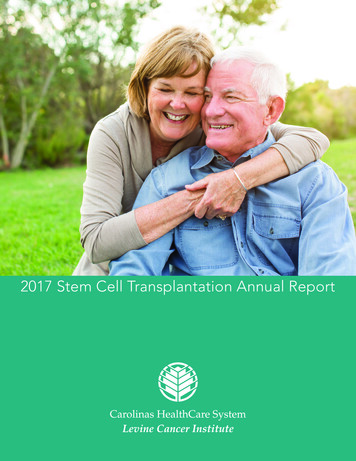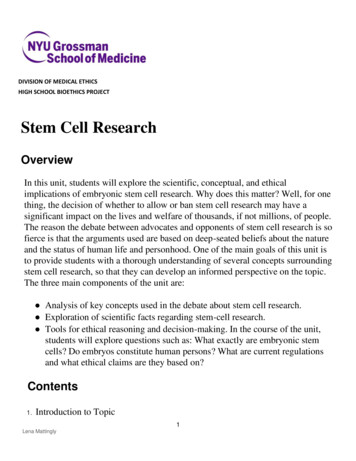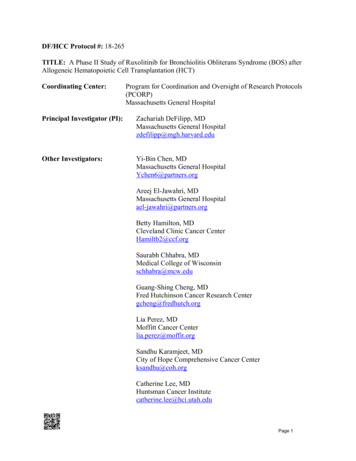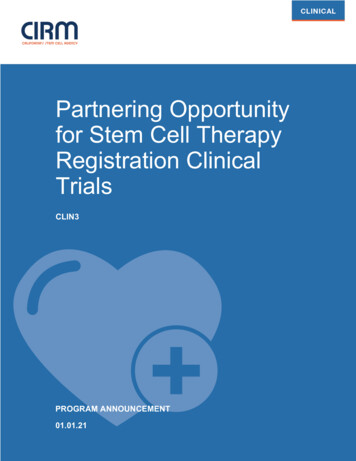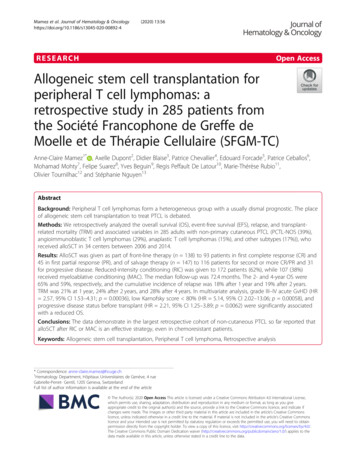
Transcription
Mamez et al. Journal of Hematology & (2020) 13:56RESEARCHOpen AccessAllogeneic stem cell transplantation forperipheral T cell lymphomas: aretrospective study in 285 patients fromthe Société Francophone de Greffe deMoelle et de Thérapie Cellulaire (SFGM-TC)Anne-Claire Mamez1* , Axelle Dupont2, Didier Blaise3, Patrice Chevallier4, Edouard Forcade5, Patrice Ceballos6,Mohamad Mohty7, Felipe Suarez8, Yves Beguin9, Regis Peffault De Latour10, Marie-Thérèse Rubio11,Olivier Tournilhac12 and Stéphanie Nguyen13AbstractBackground: Peripheral T cell lymphomas form a heterogeneous group with a usually dismal prognostic. The placeof allogeneic stem cell transplantation to treat PTCL is debated.Methods: We retrospectively analyzed the overall survival (OS), event-free survival (EFS), relapse, and transplantrelated mortality (TRM) and associated variables in 285 adults with non-primary cutaneous PTCL (PCTL-NOS (39%),angioimmunoblastic T cell lymphomas (29%), anaplastic T cell lymphomas (15%), and other subtypes (17%)), whoreceived alloSCT in 34 centers between 2006 and 2014.Results: AlloSCT was given as part of front-line therapy (n 138) to 93 patients in first complete response (CR) and45 in first partial response (PR), and of salvage therapy (n 147) to 116 patients for second or more CR/PR and 31for progressive disease. Reduced-intensity conditioning (RIC) was given to 172 patients (62%), while 107 (38%)received myeloablative conditioning (MAC). The median follow-up was 72.4 months. The 2- and 4-year OS were65% and 59%, respectively, and the cumulative incidence of relapse was 18% after 1 year and 19% after 2 years.TRM was 21% at 1 year, 24% after 2 years, and 28% after 4 years. In multivariate analysis, grade III–IV acute GvHD (HR 2.57, 95% CI 1.53–4.31; p 0.00036), low Karnofsky score 80% (HR 5.14, 95% CI 2.02–13.06; p 0.00058), andprogressive disease status before transplant (HR 2.21, 95% CI 1.25–3.89; p 0.0062) were significantly associatedwith a reduced OS.Conclusions: The data demonstrate in the largest retrospective cohort of non-cutaneous PTCL so far reported thatalloSCT after RIC or MAC is an effective strategy, even in chemoresistant patients.Keywords: Allogeneic stem cell transplantation, Peripheral T cell lymphoma, Retrospective analysis* Correspondence: anne-claire.mamez@hcuge.ch1Hematology Department, Hôpitaux Universitaires de Genève, 4 rueGabrielle-Perret- Gentil, 1205 Geneva, SwitzerlandFull list of author information is available at the end of the article The Author(s). 2020 Open Access This article is licensed under a Creative Commons Attribution 4.0 International License,which permits use, sharing, adaptation, distribution and reproduction in any medium or format, as long as you giveappropriate credit to the original author(s) and the source, provide a link to the Creative Commons licence, and indicate ifchanges were made. The images or other third party material in this article are included in the article's Creative Commonslicence, unless indicated otherwise in a credit line to the material. If material is not included in the article's Creative Commonslicence and your intended use is not permitted by statutory regulation or exceeds the permitted use, you will need to obtainpermission directly from the copyright holder. To view a copy of this licence, visit http://creativecommons.org/licenses/by/4.0/.The Creative Commons Public Domain Dedication waiver ) applies to thedata made available in this article, unless otherwise stated in a credit line to the data.
Mamez et al. Journal of Hematology & Oncology(2020) 13:56BackgroundPeripheral T cell lymphomas (PTCL) form a heterogeneous group of rare lymphomas [1], with a usually dismal prognostic.For patients treated with CHOP-like regimen, theoverall response rate is about 50% [2] and the long-termoutcome remains poor, with a 3-year event-free survival(EFS) below 50% for PTCL, except for ALK anaplasticlarge cell lymphoma (ALCL) [3]. For relapsed or refractory patients, a study including 153 PTCL patients reported a poor outcome in the absence of hematopoietictransplantation, even when receiving chemotherapy salvage regimen, with a median OS and PFS of 13.7 monthsand 5 months, respectively [4].Because of better knowledge of nosology and biologyof lymphomas, new targeted drugs have been developed,including pralatrexate and romidepsin, crizotinib forALK-positive ALCL, and brentuximab vedotin forCD30-positive PTCL with promising response rate, although the impact on long-term disease control remainsunclear [5, 6]. For eligible patients with chemosensitivedisease, the use of high-dose chemotherapy followed byautologous SCT (autoSCT) has been recommended asfirst-line consolidation therapy [7, 8], but the efficacy isstill a matter of debate [9, 10]. The incidence of relapseafter autoSCT remains high, and 30 to 40% of patientsexperience early relapse before any chance of receivingconsolidation therapy [11, 12]. The development ofCAR-T cells has revolutionized the treatment of B celllymphoma. However, targeting malignant T cells withimmunotherapy is more complex and challenging [13].In this context, the question of alloSCT for PTCL (5)remains relevant. Graft-versus-lymphoma (GVL) effecthas been described in PTCL [14]. Indeed, survival hasbeen shown to plateau after alloSCT [15], even after RIC[16]. There is also a potential effect of donor lymphocyteinfusion (DLI) in post-transplant relapse [17], andKanakry et al. reported a reduced incidence of relapse(17% compared to 66%, p 0.04) in patients who developed GvHD [18]. However, because of high TRM,recommending alloSCT for PTCL remains a matter ofdebate, and current guidelines limit its use for relapsedor refractory patients [7, 8].With the goal to analyze the outcome of alloSCT in alarge number of patients with non-primary cutaneousPTCL, we performed a retrospective analysis in 285patients.MethodsStudy design, inclusion criteria, data collection, anddefinitionsThis study was based on the SFGM-TC registry. Patientswith PTCL who underwent alloSCT in 32 centers between October 2006 and January 2014 were included.Page 2 of 12Patients with primary cutaneous T cell lymphoma younger than 15 years of age were excluded. The study wasapproved by the SFGM-TC scientific council. Informedconsent was obtained from the patients in accordancewith the Declaration of Helsinki.Complete response (CR) was defined as the completedisappearance of clinical, radiological, and laboratoryevidence of disease. Partial response (PR) was defined asa 50% or greater reduction in tumor mass. Progressivedisease (PD) was defined as a 25% increase in tumormass. Relapse was defined as the recurrence of clinicalor radiological signs of disease. Acute and chronicGvHD was graded according to international criteria[19].Statistical analysisDifferent outcomes were used, such as death, EFS, relapse, and TRM. The graft versus host disease-freerelapse-free survival (GRFS) was defined as the timewhen the first event among death, progression/relapse,grade 3–4 acute GvHD, or extensive chronic GvHD occurred after alloSCT. Survival curves were estimatedusing the Kaplan-Meier product limit estimator. Competing risk survival analysis methods were applied to estimate the cumulative incidence of relapse (CIR) (deathas a competing risk) over time from alloSCT. Factors associated with OS and therapy-related mortality (TRM)were analyzed using Cox proportional hazard models.The proportional hazard assumption was checked byexamination of the scaled Schoenfeld residuals. Occurrence of acute GvHD or chronic GvHD was treated as atime-dependent co-variable. For relapse, associationswere analyzed with the Fine and Gray models. The impact of chronic GvHD on relapse was studied with landmark analysis at different times.For each outcome, univariate analyses were first carried out, followed by multivariate analyses that includedall factors with a p value 0.1 in the univariate analyses.If needed, factors were then sequentially removed fromthe adjusted model based on AIC criteria. To explorethe impact of the conditioning regimen on OS, a propensity score was constructed, excluding patients whocould not receive MAC, i.e., patients older than 50 years,with a Karnofsky score under 70, or who had previouslyreceived autoSCT.ResultsPatients’ and treatment-related characteristics attransplantPatients’ characteristics are summarized in Table 1 andtransplant features in Table 2. Median age at transplantation was 49.5 years old. Histological subtypes werePTCL-NOS (n 110), angioimmunoblastic T lymphomas (AITL, n 83), ALCL (n 43), NK/T lymphoma
Mamez et al. Journal of Hematology & Oncology(2020) 13:56Page 3 of 12Table 1 Patients’ characteristicsN/med [min–max]PatientsPercentage285SexMale191Age at transplant (yo)Median49.5 [16–69]20–40873141–6015755 604114NOS11039AITL8329ALCL ALK 217ALCL ALK 207ALCL ALK unknown2 1ATLL166NK/T166HSTL124EATL31LGL1 1NK leukemia1 1Histological subtypeStage at diagnosisPlace of alloSCTPrevious autoSCTKarnofsky score at alloSCT67I–II3015III–IV17285Missing data83Front-line consolidation13848-CR19333-PR14515Second-line consolidation11641-CR27225-CR 2135-PR2259-PR 262Progressive disease3111No previous autoSCT19267Yes (patient in relapse after autoSCT)6623Yes (tandem auto/alloSCT)279100%933590–80%15659 70%156Missing data21med median, min minimum, max maximum, yo years old, NOS not otherwise specified, AITL angioimmunoblastic T lymphoma, ALCL anaplastic large celllymphoma, ALK / with/without anaplastic lymphoma kinase mutation, ATLL adult T cell leukemia/lymphoma, NK/T NK/T cell lymphoma, HSTL hepatosplenic T celllymphoma, EATL enteropathy-associated T cell lymphoma, LGL large granular lymphocyte leukemia, CR complete remission, PR partial remission, SCT stemcell transplantationnasal type (n 16), HSTL (n 12), EATL (n 3), Tlarge granular lymphocytic leukemia (T-LGL, n 1),and NK leukemia (n 1).The median number of treatment lines before transplantwas 2 (1, 29%; 2, 36%; 3, 26%; 3, 9%). Induction chemotherapy was mainly based on a CHOP-like regimen.AlloSCT was performed in 138 patients as part offront-line therapy (93 in first CR (CR1), 45 in first PR(PR1)), while 147 patients were allografted either assalvage therapy for progressive disease (PD; n 31) or assecond-line consolidation after CR or PR for relapseafter chemo (n 56) or after autoSCT (n 60).For the 66 patients in the cohort (23%) who experienced relapse after autoSCT, the median time betweenauto- and alloSCT was 19 months (6–105 months).At the time of alloSCT, 178 patients (62%) were in CR,76 (27%) were in PR, and 31 (11%) had PD. The mediantime from diagnosis to alloSCT was 12.6 months.
Mamez et al. Journal of Hematology & Oncology(2020) 13:56Page 4 of 12Table 2 Transplantation featuresNumberPatientsDisease status at transplantComplete responseTotal CRPartial response93CR 285Total PR76PR145PR 2 12 months27111495217462Total MAC10738TBI-based MAC67RICMAC623131Time from diagnosis to transplantGraft source178CR1Progressive diseaseConditioning regimenPercentage285Missing data4PBSC20371Bone marrow4917CB3312Sex of donor/recipientF/M7427CMV serostatusNeg/neg9232HLA matchingSibling identical12845Matched unrelated donor (10/10)10436T depletionMismatched unrelated donor135Cord blood3312Haploidentical72In vivo T depletion (ATG)14250Ex vivo T depletion41CR complete remission, PR partial remission, RIC reduced-intensity conditioning regimen, MAC myeloablative conditioning regimen, PBSC peripheral blood stemcells, CB cord blood, F female, M male, neg negative, ATG globulin anti-thymocytesThe majority (n 174; 62%) of patients received RICregimens. Compared to the RIC group, patients who received a MAC regimen were significantly younger, hadless frequently undergone a previous autoSCT, and hada shorter time from diagnosis to alloSCT and fewer CRat time of transplantation (see appendices).Twenty-seven patients were treated with a tandemauto/alloSCT (4 MAC, 23 RIC) with a median time between transplants of 98 days; before transplant, 22/27were in CR, 4/27 were in PR, and one patient had PD.GvHD prophylaxis was mainly based on cyclosporin / mycophenolate mofetil or methotrexate.Post-alloSCT outcomesAcute GvHD (grades II–IV) occurred in 30% of the patients (grades III–IV 14.7%). One third (n 106) developed chronic GvHD, which was extensive in 14.8% ofcases.Sixty-five patients experienced post-alloSCT lymphoma relapse (see appendices). Three patients whoreceived consolidation treatment (DLI, n 2; radiotherapy, n 1) for persistent post-transplant PR werein CR at the last follow-up. One patient received asecond alloSCT from the same donor because of graftrejection.One hundred and eighteen patients died during thefollow-up period. The main causes of death were GvHD(8%; n 24) and infections (10%; n 30), whereas 41patients died of lymphoma relapse (14%).Overall survival, event-free survival, relapse/progression,transplant-related mortality, and graft versus hostdisease-free relapse-free survivalThe median follow-up was 72.4 months (95% CI 69.4–79.5). One-year, 2-year, and 4-year OS were 68% (95%CI 0.63–0.74), 65% (95% CI 0.59–0.7), and 59% (95% CI
Mamez et al. Journal of Hematology & Oncology(2020) 13:560.53–0.65), respectively (Fig. 1). One-year, 2-year, and 4year EFS were 64% (95% CI 0.58–0.7), 60% (95% CI0.54–0.66), and 54% (95% CI 0.48–0.61), respectively.The cumulative incidence of relapse (CIR) was 18% after1 year (95% CI 0.13–0.23) and 19% after 2 years (95% CI0.14–0.24) (Fig. 2). The median time from transplant torelapse was 97 days, and only 10% of the relapse occurred after the first-year post-transplant. TRM was 21%at 1 year (95% CI 0.17–0.27), 24% after 2 years (95% CI0.3–0.19), and 28% (95% CI 0.34–0.23) after 4 years.GRFS at 1 year, 2 years, and 4 years was respectively 49%(95% CI 0.43–0.55), 46% (95% CI 0.40–0.52), and 43%(95% CI 0.37–0.49).Factors associated with outcomeUnivariate and multivariate analyses for OS are summarized in Table 3. In multivariate analyses, grade III–IVacute GvHD (HR 2.57, 95% CI 1.53–4.31; p 0.00036), low Karnofsky score 80% (HR 5.14, 95% CI2.02–13.06; p 0.00058), and PD versus CR beforetransplant (HR 2.21, 95% CI 1.25–3.89; p 0.0062)were significantly associated with the 5-year OS. Themain factors associated with TRM were number of linesof treatment 2 (HR 0.59, 95% CI 0.35–0.99; p 0.047) and low Karnofsky score 80% (HR 3.43, 95%CI 1.09–10.7; p 0.034) (see appendices).Outcomes according to the histologic subtypes are detailed in Table 4. Outcomes according to the timing ofalloSCT (front-line or second-line treatment) and disease status at transplant are detailed in Table 5. Of note,31 patients with PD underwent alloSCT (RIC, n 22;MAC, n 9), and among them, 7 had primary refractoryPage 5 of 12disease and received alloSCT as first-line salvage treatment. In this subgroup, 47% (n 15) reached CR aftertransplant.OS and EFS according to the disease status beforetransplant (CR1/PR1 vs CR 2/PR 2 vs PD) are illustrated in Figs. 3 and 4. The p value (log rank test) is significant (p 0.01) comparing OS (p 0.01) and EFS (p0.02) among groups. No differences were found amongthe three groups of patients for GRFS (log rank test: p 0.08).Outcomes according to conditioning regimen intensityThe 2-year CIR was 22% in the MAC group and 17% inthe RIC group. The 2-year TRM was 21% (95% CI 0.12–0.29) in the MAC group and 24% (95% CI 0.17–0.31) inthe RIC group. To note, because of a great heterogeneityin terms of TBI dose associated with various conditioning regimen, we chose to perform the comparison between MAC and RIC.Significance was tested by constructing a propensityscore after excluding patients who could not receiveMAC. We did not find any significant difference between MAC and RIC for OS (p 0.5), EFS (p 0.55),TRM (p 0.09), or relapse risk (p 0.32).Outcome according to chronic GvHDOne hundred and six developed chronic GvHD, andonly 11/106 experienced lymphoma relapse afteralloSCT. In this subgroup of patients with chronicGvHD, the 2-year OS and EFS after chronic GVHDdiagnosis were 78% (95% CI 0.7–0.87) and 68% (95% CI0.6–0.78), respectively. After landmark analysis, noFig. 1 Overall survival. This Kaplan-Meier curve represents the probability of overall survival for the all cohort, from the time of alloSCT (stem celltransplantation) to death or loss to follow-up. The continuous line represents the survival curve; the 2 dotted lines represent the 95% CI. Time isrepresented in months on the horizontal axis. Below the x-axis, the remaining patients at risk are detailed. OS at 1 year was 68% (95% CI 0.63–0.74) and was 65% (95% CI 0.59–0.7) at 2 years. OS at 4 years was 59% (95% CI 0.53–0.65)
Mamez et al. Journal of Hematology & Oncology(2020) 13:56Page 6 of 12Fig. 2 Cumulative incidence of relapse and non-relapse mortality. This curve represents the probability of cumulative incidence of lymphomarelapse (continuous line) and the probability of death without relapse/ progression (dotted line) from the time of transplant. Time is representedin months on the horizontal axis. Cumulative incidence for relapse at 1 year was 0.18 (95% CI 0.13–0.23) and at 2 years 0.19 (95% CI 0.14–0.24).Cumulative incidence for death without relapse at 1 year was 0.18 (95% CI 0.14–0.23) and 0.21 at 2 years (95% CI 0.16–0.26)significant difference on cumulative incidence of relapsewas found for patients who developed chronic GvHDcompared to the ones who did not.DiscussionTo the best of our knowledge, this series, including 285patients with non-primary cutaneous PTCL treated withalloSCT, is the largest to be reported so far. The studyshows promising results for OS and EFS (65% and 60%at 2 years, 59% and 54% at 4 years) despite the heterogeneity of the population and the retrospective nature ofthe study. A plateau was reached after 1 year for OS andEFS with fewer relapses occurring, although relapseswere responsible for the death of 14% of the patientsoverall. Pre-transplant disease status (PD vs CR) and receiving more than two lines of treatment were significantly associated with OS.One of the major issues when considering alloSCT forPTCL patients, whose median age at diagnosis is 50 to60 years old, is the TRM, which was high, and accountedfor 25% of the deaths, even in patients transplanted asfront-line consolidation. In the CIBMTR study [20],where 59 patients had alloSCT after MAC and 36 afterRIC, they reported more relapses with RIC and moreTRM with MAC, resulting in similar OS. In our study,the outcome for RIC, including TRM and CIR, appearssimilar to the outcome for MAC. These results are possibly related to the graft-versus-lymphoma effect and donot favor the use of MAC in this setting. However, dueto differences in patients’ characteristics before transplant, the comparison between MAC and RIC might notbe relevant despite the use of a propensity score.Another major unsolved question remains the role ofalloSCT as first-line consolidation for eligible patientscompared to autoSCT or chemotherapy alone [21]. First,autoSCT has never been prospectively compared tochemotherapy alone in the consolidation of a first-lineresponse for PTCL treatment. A recent matched studybased on a propensity score comparing patients managed on an institutional-based strategy of using autoSCTsystematically or not did not demonstrate any benefit ofautoSCT [9]. However, front-line autoSCT remains astandard treatment in many European countries, according to the European Society of Medical Oncology(ESMO) recommendations [21], and is still recommended in the National Comprehensive Cancer Network (NCCN) guidelines which currently also includethe addition of brentuximab in the case of CD30positive PTCL. The largest prospective autoSCT phase IItrial, done on 160 patients by the Nordic LymphomaGroup, reported a 51% OS and 44% PFS [11]. A recentmeta-analysis reported a non-negligible TRM of 2 to 6%and a relapse rate of 26 to 36% [22] after autoSCT.Given the poor prognosis of PTCL, with a cure ratenot exceeding 50%, the use of alloSCT in consolidationof a first response (CR1 or PR1) has been recommendedand accounts for 48% of the patients in the presentstudy, with a 2- and 4-year OS of 66% and 63%, EFS of61% and 57%, and CIR of 19% and 20%, respectively. Ina monocentric report, alloSCT in CR1/PR1 was systematically used in 49 consecutive PTCL patients [23].Among these patients, 29 reached CR or PR (60%) andunderwent upfront alloSCT with a 2-year OS of 72.5%and a low TRM of 8.2% (RIC, n 24; MAC, n 5).Front-line alloSCT has been prospectively evaluated andcompared to autoSCT in two studies. Corradini et al. reported a non-randomized phase II study in 37 patientsin response after chemotherapy where 23 receivedalloSCT and 14 autoSCT. The 4-year PFS was similarfor both groups (70% for autoSCT; 69% alloSCT) [24].The AATT multicentric randomized study comparedalloSCT and autoSCT as consolidation in patients
Mamez et al. Journal of Hematology & Oncology(2020) 13:56Page 7 of 12Table 3 Univariable and multivariable analyses for overall survivalHR (95% CI)p value1.00 (0.99–1.02)0.68AITL1.000.30ALCL*1.03 (0.56–1.92)ATLL1.62 (0.77–3.43)NOS0.79 (0.48–1.3)NK/T nasal1.93 (0.92–4.07)HSTL0.79 (0.24–2.6)Other subtypes1.32 (0.32–5.54)Univariable analysis for 5-year OSAge at transplantHistology subtypesTime from diagnostic to alloSCT 12 months0.9 (0.6–1.33)0.59Number of lines of treatment 20.71 (0.47–1.08)0.110.001Karnofsky score at transplant (%)Disease status at transplant1001.0080–902.08 (1.27–3.4) 804.00 (1.7–9.41)CR1.00PR0.83 (0.51–1.37)PD2.13 (1.27–3.57)HLA-matched donorConditioning regimenCMV status (D/R)0.71 (0.45–1.12)0.16MAC1.000.86RIC0.96 (0.64–1.45)Neg/neg1.00Others0.97 (0.63–1.49)Mismatch sex (F/H vs others)Source of stem cells0.0110.891.39 (0.91–2.12)0.140.022BM1.00Cord blood1.44 (0.76–2.73)PBSC0.69 (0.41–1.14)Acute GvHD (grades 3–4)2.69 (1.67–4.33)0.0002Chronic GvHD1.22 (0.72–2.06)0.47HR (95% CI)p valueMultivariable analysis for 5-year OSAcute GvHD (grade 3-4)Karnofsky score (%)2.57 (1.53–4.31)0.0003690–80 vs 1002.07 (1.24–3.44)0.0053 80 vs 1005.14 (2.02–13.06)0.00058Disease status before transplantPR vs CR0.72 (0.42–1.24)0.24PD vs CR2.21 (1.25–3.89)0.0062Stem cell sourceCord blood vs BM1.78 (0.90–3.51)0.10PBSC vs BM0.85 (0.50–1.45)0.54OS overall survival, HR hazard ratio, CI confidence interval, AITL angioimmunoblastic T lymphoma, ALCL anaplastic large cell lymphoma, ALK / with/withoutanaplastic lymphoma kinase mutation, ATLL adult T cell leukemia/lymphoma, NK/T NK/T cell lymphoma, HSTL hepatosplenic T cell lymphoma, SCT stem celltransplantation, CR complete remission, PR partial remission, PD progressive disease, MAC myeloablative conditioning regimen, RIC reduced-intensity conditioningregimen, neg negative, BM bone marrow, PBSC peripheral blood stem cells, F female, M male, GvHD graft versus host disease, D/R donor/recipient*Polled data of ALK and ALK ALCLachieving SD, PR, or CR after 4 CHOEP cycles. Thisstudy was prematurely closed following the interim analysis, and the final results were presented at the ASCOmeeting in 2019. In 103 patients (alloSCT arm, n 49;autoSCT arm, n 54), the intent-to-treat analysis failedto demonstrate any significant difference in EFS and OSbetween arms. As in other studies [11, 12, 25], one thirdof patients did not reach any consolidation due to earlyprogression. Finally, given donor availability, 41 patientsreceived autoSCT and 26 alloSCT. Despite the absenceof late relapse after alloSCT, a significant toxicity responsible for 7 out of 8 deaths prevents to reveal any
Mamez et al. Journal of Hematology & Oncology(2020) 13:56Page 8 of 12Table 4 Survival analysis according to histological lymphoma subtypesNumberOS, % (95% CI)EFS, % (95% CI)TRM, % (95% CI)CI relapse/progression, % (95% CI)1 year2 years1 year2 years1 year2 years1 year2 years68% (0.58–0.76)66% (0.58–0.76)61% (0.52–0.71)16% (0.1–0.25)20% (0.13–0.29)19% (0.12–0.27)21% (0.13–0.29)T-NOS11072% (0.61–0.79)AITL8373% (0.62–0.81)67% (0.56–0.77)71% (0.61–0.82)64% (0.54–0.76)23% (0.15–0.35)28% (0.28–0.39)10% (0.03–0.17)12% (0.04–0.19)ALCL ALK 2181% (0.57–0.92)81% (0.57–0.92)71% (0.54–0.94)71% (0.54–0.94)5% (0.01–0.32)5% (0.01–0.32)24% (0.05–0.43)24% (0.05–0.43)ALCL ALK 2055% (0.28–0.72)50% (0.28–0.68)52% (0.35–0.79)52% (0.35–0.79)34% (0.18–0.58)34% (0.18–0.58)14% (0–0.3)14% (0–0.3)NK/T1650% (0.25–0.71)50% (0.25–0.71)44% (0.25–0.76)44% (0.25–0.76)29% (0.12–0.61)29% (0.12–0.61)––ATLL1656% (0.29–0.76)56% (0.29–0.76)38% (0.2–0.71)38% (0.2–0.71)25% (0.09–0.59)25% (0.09–0.59)44% (0.18–0.69)44% (0.18–0.69)HSTL1258% (0.27–0.8)58% (0.27–0.8)64% (0.41–0.99)64% (0.41–0.99)42% (0.2–0.73)42% (0.2–0.73)––EATL367% (0.05–0.95)67% (0.05–0.95)67% (0.3–1)67% ( 0.3–1)00––OS overall survival, EFS event-free survival, TRM toxic-related mortality, CI confidence interval, NOS not otherwise specified, AITL angioimmunoblastic T lymphoma,ALCL anaplastic large cell lymphoma, ALK / with/without anaplastic lymphoma kinase mutation, NK/T NK/T cell lymphoma, ATLL adult T cell leukemia/lymphoma,HSTL hepatosplenic T cell lymphoma, EATL enteropathy-associated T cell lymphomaEFS benefit of this procedure, even when the analysis islimited to patients actually transplanted. For the authors,these results, as well as the possibility of performing salvage alloSCT in second remission, do not favor recommending alloSCT at first remission in PTCL [26].In accordance, when we evaluated the results from the116 patients who received alloSCT while in relapse, the2- and 4-year OS (66% and 61%), EFS (60% and 54%),and CIR (17% and 18%) were similar to those in patientswho received alloSCT when in first consolidation (CR1or PR1), albeit with slightly higher 4-year TRM (30%),compared to the first-line consolidation group (TRM,24%). The same GVL effect might occur in both setting,but with a higher risk of toxicity in patients receivingalloSCT when in relapse. These data show the necessityto be proactively prepared to perform salvage alloSCT,sometimes early in the disease course, because of thehigh incidence of first-line failures. Identifying patientswith suboptimal response to chemotherapy (e.g., withearly PET or other minimal residual disease (MRD)tools) might lead to earlier alloSCT consolidation if therisk of relapse is considered to be important.The role of alloSCT as consolidation compared toautoSCT has also been challenged in the relapse/refractory setting. AlloSCT is recommended along withautoSCT by the ESMO and NCCN guidelines. In the literature, the largest study reporting outcomes of the relapse/refractory PTCL setting [20] found no differencebetween alloSCT and autoSCT. However, this study includes a very high number of ALCL (40%), a subtype inwhich a better prognosis has been demonstrated compared to other PTCL subtypes when an autoSCT strategyis chosen [11], which limits the scope of conclusions to allsubtypes. In addition, patients in the alloSCT group hadreceived more treatment lines before transplantation, wereless chemosensitive, and had worse remission status attransplantation. The role of alloSCT in other retrospectivestudies reported encouraging long-term OS post-alloSCT,around 50% [27–33]. With a 30–50% long-lasting survivalafter alloSCT for relapsed PTCL, the authors of a recentreview concluded that alloSCT is a valid option for patients who are eligible, at least after the first relapse, although more prospective studies are also needed in thearea of new targeted treatments [34].Table 5 Outcomes for all the group and according the timing of alloSCT (front-line, second-line treatment, or progressive disease)Number Overall survival, % (95% CI)Cumulative incidence of relapse,% (95% CI)TRM, % (95% CI)GRFS, %(95% CI)2-year OS4-year OSAt 2 years2-year TRM4-year TRM2-year GRFSAll group28565% (0.59–0.7)59% (0.53–0.65)19% (0.14–0.24)24% (0.3–0.19)28% (0.34–0.23)46% (0.4–0.52)Front-line alloSCT (CR1 PR1)13866%(0.58.0.74)63% (0.53–0.7)19% (0.12–0.25)23% (0.16–0.31)24% (0.17–0.32)48% (0.39–0.56)CR19371% (0.6–0.79)62% (0.51–0.71)14% (0.13–0–51)26% (0.53–0.74)27% (0.38–0.19)48% (0.37–0.58)Second-line alloSCT (CR 2 or 116PR 2)66% (0.56–0.74)61% (0.51–0.7)17% (0.1–0.24)25% (0.18–0.35)30% (0.22–0.4)45% (0.36–0.54)Progressive disease55% (0.36–0.7)37% (0.2–0.54)32% (0.13–0.52)24% (0.46–0.12)40% (0.63–0.23)30% (0.19–0.56)31SCT stem cell transplantation, TRM toxic-related mortality, OS overall survival, CR complete remission, PR partial remission, GRFS graft versus host disease-freerelapse-free survival
Mamez et al. Journal of Hematology & Oncology(2020) 13:56Page 9 of 12Fig. 3 Overall survival for patients allotransplanted in front-line consolidation (CR1/PR1), second-line consolidation (CR2 or more /PR2 or more),and/or refractory/progressive disease. This curve represent the probability of overall survival from the time of alloSCT (stem cell transplantation)for patients allotransplanted in front-line consolidation (pointed line, CR1/PR1), second-line consolidation (continuous line, CR2 or more/PR2 ormore), and/or refractory/progressive disease (dotted line). The gray zones represent the 95% CI for each subgroup. Time is represented in monthson the horizontal axis. Below the x-axis, the number of patients at risk for each group is detailed. The p value (log rank test) is significant (p 0.01) comparing OS among groupsOne of the major challenges in the treatment of relapsed or refractory PTCL is to induce disease controlvia bridging therapies to transplantation, especially considering that this population may be underestimated instudies because they do not reach consolidation. In theBritish Columbia Cancer Agency Lymphoid Cancerdatabase study, only 38 patients (20%) received a transpla
For patients treated with CHOP-like regimen, the overall response rate is about 50% [2] and the long-term . This study was based on the SFGM-TC registry. Patients . (1, 29%; 2, 36%; 3, 26%; 3, 9%). Induction chemo-therapy was mainly based on a CHOP-like regimen. AlloSCT was performed in 138 patients as part of
